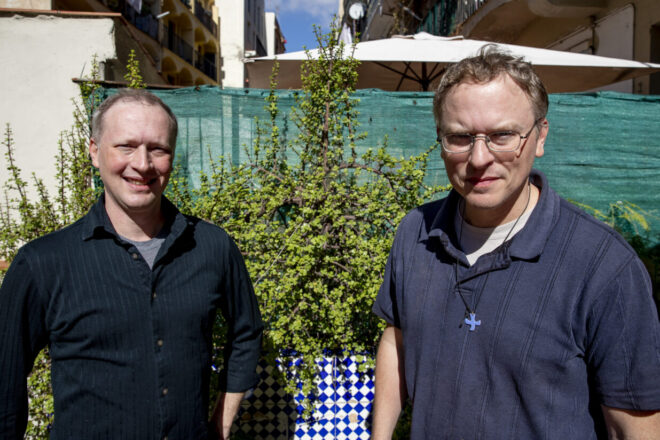17.10.2022 - 09:00
|
Actualització: 11.11.2022 - 12:55
The history of the independence process is also the history of changes in civil disobedience in Catalonia. Over the last decade it has engaged in citizen-led campaigns which began with “No vull pagar” [“I’m not paying”, protesting road tolls in Catalonia] and which culminated in the 1 October 2017 independence referendum. In “This is an Uprising”, activists Mark and Paul Engler approach the practice of non-violent resistance from a theoretical perspective by analysing approximately a dozen examples from different times and places. I took the opportunity to speak to the Engler brothers about civil disobedience and its importance in the Catalan context while they were visiting Barcelona at the invitation of the International Institute for Non-violent Action (Novact).
—Polarization is a concept which politicians seek to avoid. However, you see it as essential for social movements to succeed.
—Mark Engler [M. E.]: Politicians and the general public see polarization as a negative. But for social movements polarization is absolutely crucial, since it forces people to take a stand. For example, in his most recent book journalist Ezra Klein writes that the opposite of polarization is not unity, as is often thought, but the suppression of socio-political problems. In the absence of polarization, these problems obviously remain important, but they simply cease to be spoken about.
—Paul Engler [P. E.]: Politicians and the public often think that polarization is destructive, that solving problems requires unity. They believe that unity can only be achieved by easing tensions. But if you look at the great victories of social movements in history, you’ll see that the vast majority were achieved after years of fuelling polarization, not through seeking conciliation.
—You state that political leaders aren’t the driving force of change, but rather public opinion is. However, you also acknowledge that social and cultural factors affect what society considers to be violence and repression.
—P. E.: We’re not interested in civil disobedience for its moral value, but rather for its strategic value. Most people —and many activists— lack any conceptual framework to evaluate whether a protest is effective or not, which is why debate often tends to gravitate towards the field of morality, towards the question of whether a particular action is morally justified. However, for an action to be effective it must be polarizing and, therefore, controversial. Which is why it’s important that social movements seek this balance, that they try to find an action which is controversial while also drawing public sympathy. Nevertheless, it’s a criterion which varies from one country to another: in the US, for instance, we know that as soon as acts of vandalism take place in a protest, people turn their backs on it. But in Latin America, for example, vandalising property is seen to be a natural part of a protest, and it’s not particularly polarizing. So the cultural context matters. But to be clear: it’s important to focus on the question of what effect an action has, not whether it’s justified or not.
— However, this presupposes that the public opinion sympathizes with the victims of repression from the outset. I’m thinking of Spain here, where the persecution of the independence movement doesn’t seem to have substantially changed public opinion.
—M. E.: There are civil resistance theorists, such as Gene Sharp, who would tell you that appealing to your opponent’s conscience is always positive, but not strictly necessary. The objective of movements such as Catalonia’s shouldn’t be to convince their opponent, but rather to marginalize and delegitimize them. This “moral conversion” is very important in Gandhi’s non-violence, but not so much in the strategic non-violence that we support. In strategic non-violence, the key is to highlight the violence which maintains the status quo. It is the so-called “paradox of oppression”. Many states believe that repression is an effective way to crush dissent and prevent people from organizing, but it often turns out that repression ends up having quite the opposite effect: people witness scenes of violence, become outraged and decide to take action. This isn’t always the case, however: sometimes, unfortunately, repression is effective, especially in dictatorial regimes that kill and imprison dissidents with impunity. This is why you must try to anticipate the state’s reaction when protesting and you must prepare for the possibility of repression. It’s no easy task.
—On a personal level, repression is always catastrophic. But you say it’s indispensable for the success of a movement.
—P. E.: I think it’s unfair to say that social movements actively seek repression, but it’s true that a social movement is effective when it knows how to anticipate state repression, when it anticipates the consequences of repression: it’s the paradox of repression that we mentioned earlier. When examining the growth of a movement, we focus on three key elements: sacrifice, disruption and escalation. If I protest alone in my backyard, no one will care. But if I and other people come together and we protest in the middle of the street or occupy a politician’s office, for example, suddenly our demands will be much harder to ignore and it’ll be much easier to gain public attention. This is where the idea of sacrifice comes into play: if the public perceives something as a sacrifice, they’ll be more sympathetic to your cause and more likely to be polarized in your favour. This can happen without state intervention –with a hunger strike, for instance– but state repression obviously accelerates this process. If we look at the history of many social movements, we’ll see that they began to take off when the state intervened to suppress them.
—M. E.: In the literature on civil disobedience there’s the concept of “political aikido”, which involves using your opponent’s momentum against them. This is something we see time and again in the case of social movements: state repression, particularly if it’s brutal, has a boomerang effect which helps boost public support for the cause. That’s why non-violence is so important: it helps to “protect” movements so that when the crackdown comes, people will sympathize with them. In contrast, if the movement has been violent, the public’s perception is often that the state’s crackdown is justified.
—Do we need martyrs?
—P. E.: I don’t know if we can say that martyrs are strictly necessary for a movement to be successful. But it’s a fact that the history of civil disobedience is filled with martyrs. To paraphrase Gandhi’s famous quote, no nation has been born without the blood of its martyrs. The sacrifice of the people who die for the cause is certainly one of the great forces which propels a movement and helps it garner public support. If a movement gains enough momentum, it’s almost inevitable that there will be some martyrs. Gene Sharp, the civil disobedience theorist, says –and I agree– that it’s naive to think that no one will die in a non-violent struggle. It’s clear that there will be deaths, and these deaths can be a source of power and strength for the movement.
—M. E.: Obviously, that doesn’t mean to say that we believe social movements ought to seek repression and martyrdom. But a mature movement must be aware that repression and martyrs are a risk of the struggle, and they have to bear this possibility in mind when taking action.
—You explain how social movements progress cyclically: there are periods of high activity, which do not usually last more than a couple of months, and periods of low activity, which can last for years.
—P. E.: The public and media often fail to understand that social movements don’t progress in a linear fashion, that there are periods of high activity and periods of low activity. It’s vital that we understand this, since movements often grow out of specific events that push their demands into the public imaginary. When this happens, it may briefly appear that the movement is unstoppable, but inevitably there comes a point where it begins to decline, and people conclude that the movement has failed.
—M. E.: In a situation like this, it’s easy to succumb to cynicism. But if you study the history of social struggle, you’ll see that movements actually progress in cycles, and that they often grow thanks to external events which force people to take to the streets and trigger a spike in activity. But it’s during these lulls when movements gain the public’s passive support, which is crucial to the long-term success of the cause. In the short term one doesn’t appreciate this. But it’s incredibly important. We estimate that social movements need an average of fifteen years, roughly, for their claims to take root in the collective imaginary.
— It looks as if the Catalan independence movement finds itself in this second stage…
—M. E.: First of all, I must say that I sympathise greatly with all the activists who feel tired of fighting, apparently without any result. It’s difficult. And I understand that there are pro-independence supporters who may be feeling down because the movement is not progressing. But if you study the history of movements across the world, you’ll see that these very short boom-and-bust cycles have happened over and over again. When I realised this, it really boosted my self-esteem. There is a chart by Bill Moyer, another civil disobedience theorist, which shows exactly how social movements go through these boom-and-bust cycles. This graph gives a lot of hope to activists, because they see, to put it bluntly, that all is not lost. I always say that fixating on immediate results prevents activists from seeing the changes they have achieved. But we ought to see how they’ve transformed society, how they’ve managed to build enormous organizational structures which have changed people’s minds.
—They also say that these peaks of activity ought to be integrated into the movement’s structure and organization. I’m thinking of the case of Catalonia’s Democratic Tsunami, a formidable mobilization apparatus which the independence movement has gradually allowed to peter out.
—P. E.: This is the great challenge facing a movement: how do you create the structures which are able to absorb, in the long term, everyone who takes to the streets at times of great mobilization? Mass mobilizations are, by definition, temporary phenomena, and as such they cannot replace the grassroots organizational work which sustains a movement. The Democratic Tsunami was incredibly effective at prompting mobilization, but we can’t expect it to do more than that. But instead of making such an analysis, we tend to think that it was a failure because after the protests in the autumn of 2019 it fell into disuse. I think we need to take a longer-term view: at that time, was the Tsunami the best option to increase mobilization and maintain the independence movement’s momentum? Movements often need temporary mobilization channels, such as the Democratic Tsunami, which can continue building tension when other organizations are unable to do so.
—M. E.: Let’s go back to the example of the cancellation of student loans in the United States. Many people in the movement see the prospect of cancellation as a defeat because Biden decided to cancel $10,000 per person, as opposed to the whole debt, as many activists demanded. Yes, $10,000 is a concession. However you look at it, we’re talking about a lot of cash, it’s an amount which can affect people’s lives in a very positive way. As soon as a measure like this is introduced, politicians aim to capitalise on it -even those who never supported it in the first place, like President Biden himself. But years and years of pressure, of social and political struggle, lie behind this measure. People often overlook this because they tend to have a monolithic view of politics which attributes changes to those responsible for introducing them. But that’s how it is.
—Are you sceptical about the importance of leaders in social movements?
—M. E.: We aren’t against leaders. We need leaders, and of course not everyone can lead. But we are highly critical of a charismatic or centralized leadership. A movement cannot depend on a small group of leaders because, in the face of state repression, they are likely to cave in, for example, out of fear of being sent to prison. I don’t know enough to comment on the specific case of Catalan independence, but I would say that a movement that relies on its leaders too much is a vulnerable movement. It’s important that political movements don’t perpetuate this monolithic mythology which identifies the cause with one or several visible faces.
—All the movements you analyse in This is an Uprising have one thing in common: they were long and arduous struggles. Years, if not decades.
—M. E.: People, and even activists, often examine the achievements of a movement on a very short time scale: you take action and you are expected to achieve your demands immediately. But social and political demands often take a long time to materialize. Independence is a good example of what I’m talking about. The question is not whether the tactics that have been used so far have been effective, in an immediate sense. The question is whether these tactics have helped to grow the movement, whether they’ve strengthened its organizations and allowed it to drum up more resources. And I’d say the answer is yes.



